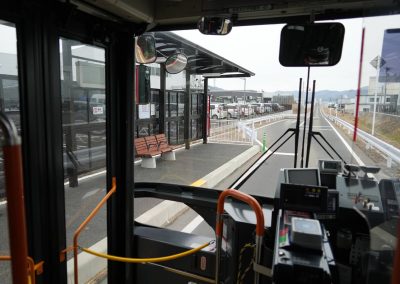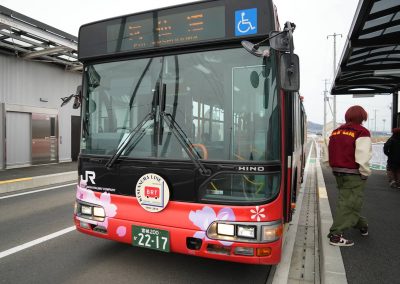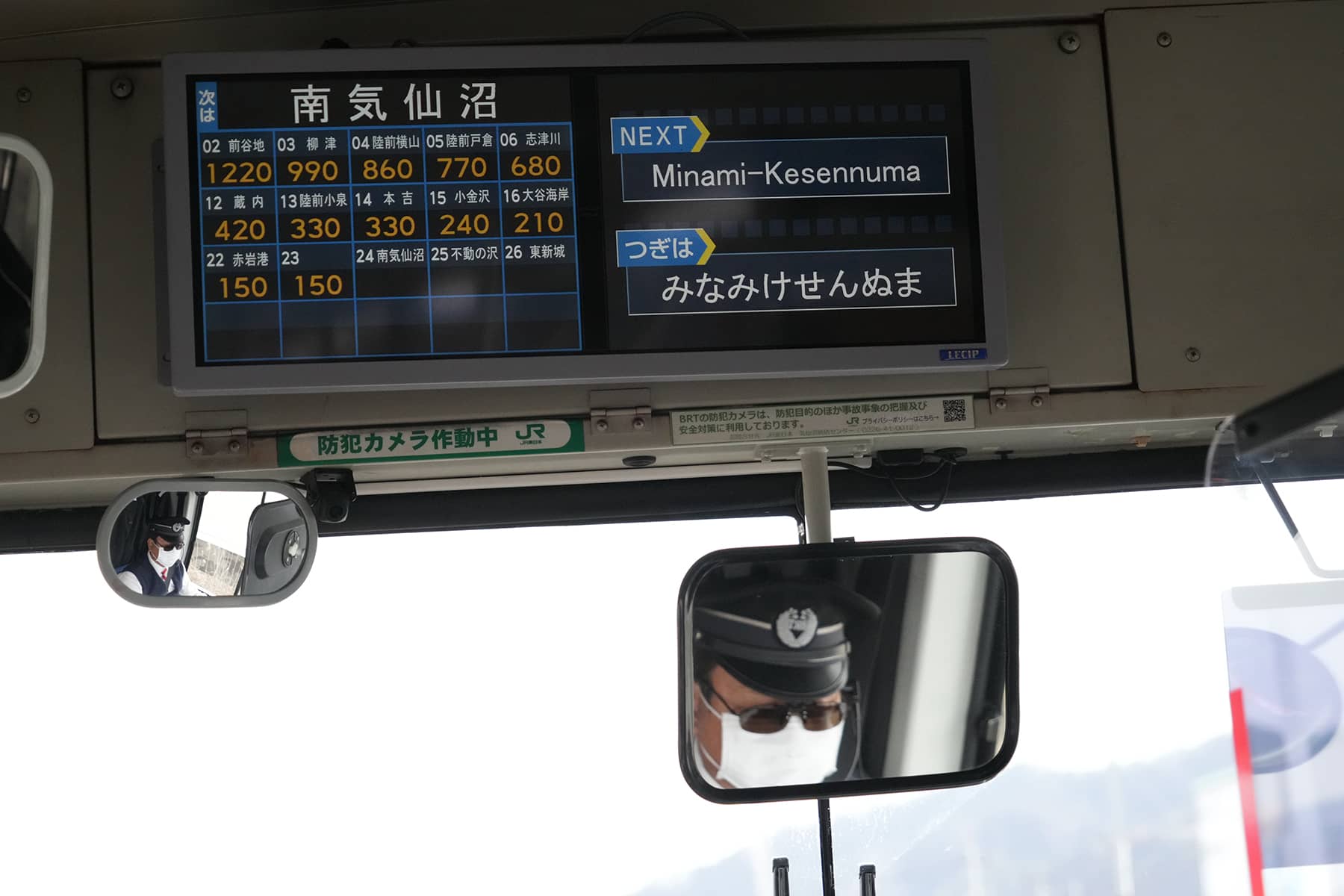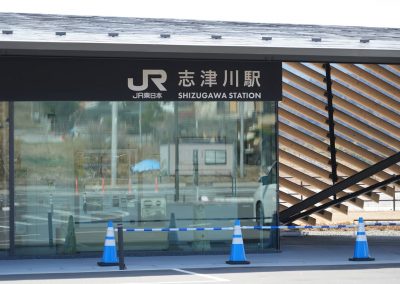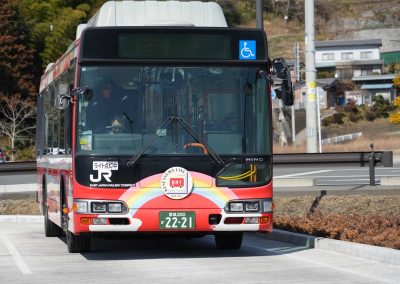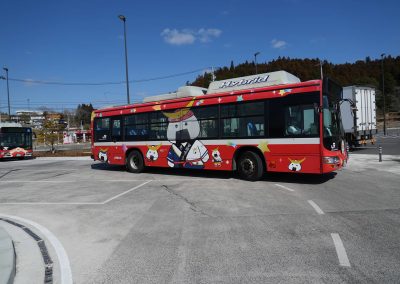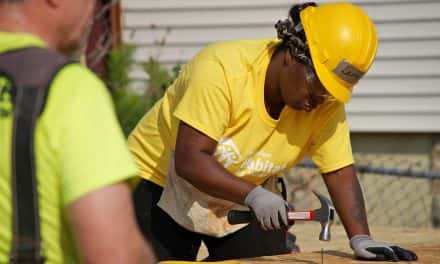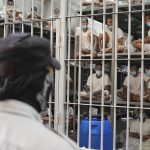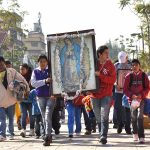
Following the devastating Great East Japan Earthquake and tsunami in 2011, the East Japan Railway Company’s Kesennuma and Ofunato lines along the northeastern coastal regions faced unprecedented disruption.
The catastrophe razed core infrastructure corridors and highlighted the pressing need for a resilient and flexible transportation system. East JR’s introduction of the Bus Rapid Transit (BRT) system in 2012 heralded a new era of commuting, by blending the efficiency of buses with the structured network of trains.
While the BRT concept lacked a standardized definition in Japan at that time, the idea of an intermodal transit system promised a quicker recovery for the tsunami-affected areas. But by 2024, the reality on the ground still falls short of long-standing expectations. But much of the disconnect is related to changing social patterns, and the persistent legacy of 3-11.
The seismic event of 2011 left the Kesennuma and Ofunato lines in ruins, highlighting the inherent challenges in railway restoration. Traditional rail lines, with their fixed tracks and extensive construction demands, posed significant delays and financial burdens in the face of urgent recovery needs.
Additionally, the essential daily commute for local high school students accelerated awareness of the immediate necessity for a dependable transportation solution.
East JR’s strategic pivot to BRT emerged from that critical juncture. Proposing an innovative approach, East JR commenced BRT services on dedicated roadways, ensuring uninterrupted access for essential travel needs. The Kesennuma Line witnessed a swift temporary restoration by 2012, followed by the Ofunato Line in 2013. The effort showcased the BRT’s pivotal role in disaster recovery and community support.
Unlike traditional rail services, which required complete restoration before resuming operation, BRT was incrementally implemented along available sections of the route over the years, significantly expediting the recovery process.
The conversion of damaged railway tracks to asphalt-paved roads for BRT usage facilitated not just the restoration of transportation services but also the integration of those services into the broader efforts of urban redevelopment.
Such a system was particularly useful in areas where entire towns had to be relocated due to tsunami damage, requiring a reimagined approach to urban planning and public transportation.
As towns rebuilt and evolved, so too did the BRT routes, adapting to new urban layouts and community needs. Such flexibility has been a hallmark of the BRT system, allowing for route modifications and the creation of new stops in response to the development of new civic amenities and community centers.
The collaborative process between JR East and local municipalities also ensured that the BRT system served as a catalyst for regional development.
The transformation from rail to road entailed the conversion of damaged tracks into dedicated BRT lanes, aligning with post-disaster urban redevelopment. The BRT’s flexible routing adapted to the evolving landscapes, where towns relocated to safer grounds, necessitating adjustments in the transit network.
Approximately 40% of the BRT route now traverses private roads, embedding the system into the fabric of newly built communities, from town halls to hospitals, ensuring that vital services are within reach.
One of the standout benefits of adopting BRT over traditional rail has been its operational flexibility. Where railways are constrained by single-track limitations and fixed schedules, BRT offers a dynamic alternative. The ability to increase service frequency, especially during peak hours, significantly enhances commuter convenience, mitigating the wait times characteristic of less frequent train services.
BRT’s modularity also allows for phased implementation and route adjustments in response to infrastructural developments and community needs. The agility positions BRT as a future-forward solution, capable of evolving with the regions it serves.
The success of BRT in the Kesennuma and Ofunato lines addressed the immediate challenges post-disaster, and illuminated the path forward for addressing broader transportation issues. Across Japan, regions grappling with the sustainability of local transit systems view BRT as a viable alternative, balancing cost-efficiency with service flexibility.
However, the journey of BRT’s implementation has experienced unforeseen challenges, such as the acute shortage of bus drivers. The lack of workers prompted East JR to explore innovative solutions like automated driving systems.
While BRT has proven its worth in the context of disaster recovery and urban planning synergy, its applicability varies across regions. Factors such as traffic congestion, climate conditions, and specific local needs dictate the feasibility and design of BRT systems. A nuanced understanding of those elements is crucial for crafting transportation solutions that resonate with the unique characteristics of each region.
As BRT continues to evolve and expand, its role in shaping the future of public transportation in Japan is increasingly evident. The system remains a key player in the ongoing dialogue about modern transportation infrastructure.
3.11 Exploring Fukushima
- Journey to Japan: A photojournalist’s diary from the ruins of Tōhoku 13 years later
- Timeline of Tragedy: A look back at the long struggle since Fukushima's 2011 triple disaster
- New Year's Aftershock: Memories of Fukushima fuels concern for recovery in Noto Peninsula
- Lessons for future generations: Memorial Museum in Futaba marks 13 years since 3.11 Disaster
- In Silence and Solidarity: Japan Remembers the thousands lost to earthquake and tsunami in 2011
- Fukushima's Legacy: Condition of melted nuclear reactors still unclear 13 years after disaster
- Seafood Safety: Profits surge as Japanese consumers rally behind Fukushima's fishing industry
- Radioactive Waste: IAEA confirms water discharge from ruined nuclear plant meets safety standards
- Technical Hurdles for TEPCO: Critics question 2051 deadline for decommissioning Fukushima
- In the shadow of silence: Exploring Fukushima's abandoned lands that remain frozen in time
- Spiral Staircase of Life: Tōhoku museums preserve echoes of March 11 for future generations
- Retracing Our Steps: A review of the project that documented nuclear refugees returning home
- Noriko Abe: Continuing a family legacy of hospitality to guide Minamisanriku's recovery
- Voices of Kataribe: Storytellers share personal accounts of earthquake and tsunami in Tōhoku
- Moai of Minamisanriku: How a bond with Chile forged a learning hub for disaster preparedness
- Focus on the Future: Futaba Project aims to rebuild dreams and repopulate its community
- Junko Yagi: Pioneering a grassroots revival of local businesses in rural Onagawa
- Diving into darkness: The story of Yasuo Takamatsu's search for his missing wife
- Solace and Sake: Chūson-ji Temple and Sekinoichi Shuzo share centuries of tradition in Iwate
- Heartbeat of Miyagi: Community center offers space to engage with Sendai's unyielding spirit
- Unseen Scars: Survivors in Tōhoku reflect on more than a decade of trauma, recovery, and hope
- Running into history: The day Milwaukee Independent stumbled upon a marathon in Tokyo
- Roman Kashpur: Ukrainian war hero conquers Tokyo Marathon 2024 with prosthetic leg
- From Rails to Roads: BRT offers flexible transit solutions for disaster-struck communities
- From Snow to Sakura: Japan’s cherry blossom season feels economic impact of climate change
- Potholes on the Manga Road: Ishinomaki and Kamakura navigate the challenges of anime tourism
- The Ako Incident: Honoring the 47 Ronin’s legendary samurai loyalty at Sengakuji Temple
- "Shōgun" Reimagined: Ambitious TV series updates epic historical drama about feudal Japan
- Enchanting Hollywood: Japanese cinema celebrates Oscar wins by Hayao Miyazaki and Godzilla
- Toxic Tourists: Geisha District in Kyoto cracks down on over-zealous visitors with new rules
- Medieval Healing: "The Tale of Genji" offers insight into mysteries of Japanese medicine
- Aesthetic of Wabi-Sabi: Finding beauty and harmony in the unfinished and imperfect
- Riken Yamamoto: Japanese architect wins Pritzker Prize for community-centric designs
MI Staff (Japan)
Lее Mаtz
3.11 Exploring Fukushima: The Tōhoku region of Japan experienced one of the worst natural disasters ever recorded when a powerful earthquake was followed by a massive tsunami, and triggered an unprecedented nuclear crisis in 2011. With a personal connection to the tragedies, Milwaukee Independent returned for the first time in 13 years to attend events commemorating the March 11 anniversary. The purpose of the journalism project included interviews with survivors about their challenges over the past decade, reviews of rebuilt cities that had been washed away by the ocean, and visits to newly opened areas that had been left barren by radiation. This special editorial series offers a detailed look at a situation that will continue to have a daily global impact for generations. mkeind.com/exploringfukushima












